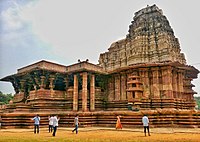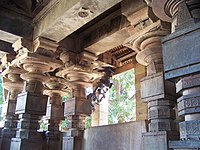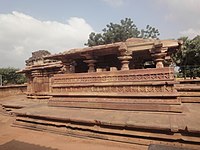Ramappa Temple
| Ramappa Temple | |
|---|---|
 | |
| Religion | |
| Affiliation | Hinduism |
| District | Mulugu |
| Deity | Ramalingeswara Swamy[1] |
| Festivals | Maha Shivaratri |
| Location | |
| Location | Palampet village |
| State | Telangana |
| Country | India |
 Location in Telangana | |
| Geographic coordinates | Coordinates: 18°15′33″N 79°56′36″E / 18.25917°N 79.94333°E |
| Architecture | |
| Architect(s) | Ramappa |
| Type | Kakatiya style, Bhumija/Vesara style |
| Creator | Recharla Rudra |
| Completed | 13th Century |
| Direction of façade | East-facing |
| Official name: Kakatiya Rudreshwara (Ramappa) Temple, Telangana | |
| Criteria | Cultural: (i)(iii) |
| Designated | 2021 (44th session) |
| Reference no. | 1570 |
Ramappa Temple, also known as the Rudreshwara temple, is a UNESCO World Heritage Site located in Telangana, India. It is 15 km (9.3 mi) from Mulugu, 66 km (41 mi) from Warangal, 209 km (130 mi) from Hyderabad. An inscription in the temple says it was constructed in the year 1213 CE by Recharla Rudra—a General of Kakatiya ruler Ganapati Deva 1199–1262.[1][2][3] Located in the vicinity of Ramappa Lake, the Ramappa Temple complex which consist of three temples was constructed between 1212 and 1234, designed and architect by Ramappa—after whom the temple complex is named.[4]
The temple is a Sivalayam, where Lord Ramalingeswara is worshipped. Marco Polo, during his visit to the Kakatiya empire, allegedly called the temple "the brightest star in the galaxy of temples".[5] Ramappa Temple stands majestically on a 6-foot (1.8 m) high star-shaped platform. The hall in front of the sanctum has numerous carved pillars that have been positioned to create an effect that combines light and space wonderfully. The temple is named after the sculptor Ramappa, who built it, and is perhaps the only temple in India to be named after its craftsman.[5]
The main structure is in a reddish sandstone, but the columns round the outside have large brackets of black basalt which is rich in iron, magnesium and silica. These are carved as mythical animals or female dancers or musicians, and are "the masterpieces of Kakatiya art, notable for their delicate carving, sensuous postures and elongated bodies and heads".[6] On 25 July 2021, the temple was inscribed as a UNESCO World Heritage Site as "Kakatiya Rudreshwara (Ramappa) Temple, Telangana".[2][7]
Description[]
The roof (garbhalayam) of the temple is built with bricks, which are so light that they are able to float on water.[8]
Some bricks of the Ramappa temple and Humayun's tomb were sent for examination to Dr. Habib Haman, Chief Chemist of Government Industrial Laboratory, Hyderabad, Dn. He has kindly reported as follows: 'The samples of floating bricks from Bidar are similar to those from Warangal as far as the method of manufacture is concerned. The material used to make the brick spongy was apparently saw-dust. The weight of the specimens is 1⁄3 to 1⁄4 of the ordinary bricks of the same size. The Bidar specimens show better quality as regards homogeneous mixing and uniform burning than their proto-types from Ramappa, as a result of which the porosity is well-maintained in the body of bricks from Bidar and they float well in water, the reason for this could be that the Ramappa temple was built almost three centuries prior to the Humayun's tomb.[9]
[verify]
There are two small Shiva shrines on either side of the main temple. The enormous Nandi within, facing the shrine of Shiva, remains in good condition.
Nataraja Ramakrishna revived Perini Sivatandavam (Perini Dance), by seeing the sculptures in this temple. The dance poses, written in Nritta Rathnavalid by Jayapa Senaani, also appear in these sculptures.
The temple remained intact even after repeated wars, plunder and destruction during wars and natural disasters. There was a major earthquake during the 17th century which caused some damage. It survived the earthquake due to its 'sandbox technique' of laying foundation.[10]
Many of the smaller structures were neglected and are in ruins. The Archaeological Survey of India has taken charge of it. The main entrance gate in the outer wall of the temple is ruined.[11]
Location[]
Ramappa temple is located in Palampet, Venkatapur mandal which is 19 km (12 mi) from Mulugu mandal (around 70 km (43 mi) off Warangal city). It is located 6 km (3.7 mi) away from Kota Gullu where another Shiva temple is located.
Nearest cities[]
- Warangal - 66 km
- Ramagundam - 94 km
- Karimnagar - 113 km
- Nizamabad - 116 km
- Khammam - 153 km
- Suryapet - 180 km
- Hyderabad - 209 km
- Nalgonda - 214 km
- Vijayawada - 275 km
- Mahbubnagar - 326 km
Gallery[]

From the side

Front

From behind

One of the distinctive dancers

Dancer

Pillar inside the mandapa

Inside the mandapa
Smaller temple
References[]
- ^ a b Gollapudi Srinivasa Rao (January 2015). "Ramappa temple never fails to surprise visitors". The Hindu. Retrieved 1 January 2015.
- ^ a b Nanisetti, Serish (25 July 2021). "Telangana's Ramappa Temple inscribed as a World Heritage Site". The Hindu (in en-IN). ISSN 0971-751X. Retrieved 25 July 2021.
{{cite news}}: CS1 maint: unrecognized language (link) - ^ Putcha 1978, p. 143.
- ^ Saravanan 2014, pp. 29–35.
- ^ a b Dobbie 2006, p. 36.
- ^ Michell & Davies 1989, p. 385.
- ^ UNESCO (25 July 2021). "Cultural sites in China, India, Iran and Spain inscribed on UNESCO's World Heritage List". UNESCO. Retrieved 25 July 2021.
- ^ "Telangana Tourism - Visit for all reasons & all seasons". Telangana Tourism. Archived from the original on 8 August 2018.
{{cite web}}: CS1 maint: unfit URL (link) - ^ Bidar, Its History and Monuments, Yazdani, G., https://books.google.co.in/books?id=w6xpQpOCtzAC, 1947, Oxford University Press, p. 133
- ^ "Did Kakatiya rulers hold the secret to earthquake-proof buildings?". The New Indian Express. Retrieved 26 July 2021.
- ^ "Warangal Temples, Telangana". Retrieved 11 September 2006.
Bibliography[]
- Putcha, Vasudeva Parabrahma Sastry (1978). N. Ramesan (ed.). The Kākatiyas of Warangal. Hyderabad: Government of Andhra Pradesh. OCLC 252341228.
- Saravanan, V. Hari (2014). Gods, Heroes and their Story Tellers: Intangible cultural heritage of South India. Notion Press. ISBN 9789384391492. OCLC 907582842.
- Dobbie, Aline (2006). India: The Elephant's Blessing. Melrose Press. ISBN 978-1-905226-85-6. OCLC 74119289.
- Michell, George; Davies, Philip H. (1989). The Penguin Guide to the Monuments of India, Volume 1: Buddhist, Jain, Hindu. London: Penguin Books. ISBN 0-14-008144-5.
External links[]
| Wikimedia Commons has media related to Ramappa Temple. |
- Hindu temples in Hanamkonda district
- Tourist attractions in Warangal
- Archaeological sites in Telangana
- Shiva temples in Telangana
- Hindu temples in Telangana
- World Heritage Sites in India
- Mulugu district
















